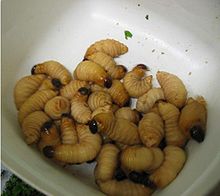Mojojoy
 Rhynchophorus ferrugineus larvae | |
| Place of origin | Ecuador,Colombia, Peru |
|---|---|
| Region or state | Amazon |
| Main ingredients | beetle larvae |
Mojojoy or Chontacuro[1] is the name of larvae of different palm weevils found in the Oriente (Ecuador) and the Amazon region of Colombia, eaten as food and are known as a pest for various palm species.[2] In Peru, it is known as suri or cocotero.[3] The flavor has had different descriptions including resembling the taste of hazelnut or butter.[3] It is also considered a sustainable food source.[3]
Characteristics
[edit]They are the larvae of Ancognatha scarabaeoides[4] and Rhynchophorus palmarum[5] which are considered pests that can attack crops, destroying them partially or totally, or affecting them from the root.[2] The weevils burrow into the aguaje tree, lays eggs, and after hatching, the grubs feed on the oily bark.[3] It is speculated that the fatty flavor comes from this.[3]
Consumption
[edit]
It can be eaten alive or prepared by different methods of cooking; most commonly they are roasted or fried, grilled on a skewer, or stuffed with beef, chicken or fish.[2][5][6] To eat raw, the head, pincers, and intestines are removed and the contents are sucked out.[3] It can be prepared in the anticucho style, which is grilling after marination. Chicharrón de suri is a dish where the grubs are seasoned with salt and garlic, then fried with green plantains.[3]
Nutrition
[edit]The larvae are a good source of protein, vitamins A and E, and beta-carotene.[3]
References
[edit]- ^ "Chontacuro, el gusano con sabor exquisito que se come en Ecuador". www.eloriente.com.
- ^ a b c "Culinaria del Amazonas, la más Exótica". Marca País Colombia (in Spanish). 2017-06-28. Retrieved 2022-02-03.
- ^ a b c d e f g h "Suri Grubs". Atlas Obscura. Retrieved 2022-02-03.
- ^ Marino, Paula; Villamizar, Laura; Espinel, Carlos; Cotes, Alba Marina (1990-01-06). "Caracterización de prototipos de bioplaguicidas granulados a base de Metarhizium anisopliae para el control de Ancognatha scarabaeoides (Coleóptera: Nelolonthidae)". Revista Colombiana de Entomología (in Spanish). 30 (1): 43–49. ISSN 0120-0488. Retrieved 2022-02-03.
- ^ a b "APROXIMACIÓN AL RECONOCIMIENTO DEL POTENCIAL ZOOTÉCNICO DE LARVAS DE Rhynchophorus palmarum (COLEOPTERA: CURCULIONIDAE) EN EL MUNICIPIO DE LETICIA - AMAZONAS, COLOMBIA". Fundación Alejando Ángel Escobar - Para fomentar y difundir la investigación, la ciencia y la solidaridad en Colombia (in Spanish). Retrieved 2022-02-03.
- ^ Abadía, Ximena; Pazos, Sonia; Castillo, Silvana; Pachón, Helena (September 2010). "Alimentos autóctonos de las comunidades indígenas y afrodescendientes de Colombia". Archivos Latinoamericanos de Nutrición. 60: 211–219.
